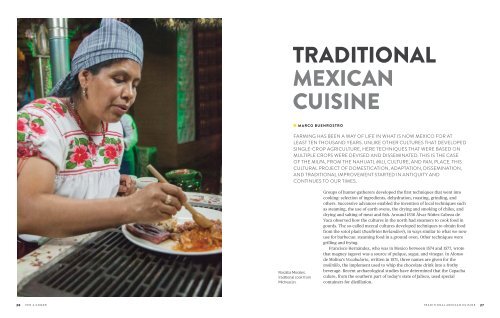ven-a-comer-e-book-en_1
ven-a-comer-e-book-en_1
ven-a-comer-e-book-en_1
Create successful ePaper yourself
Turn your PDF publications into a flip-book with our unique Google optimized e-Paper software.
Traditional<br />
Mexican<br />
Cuisine<br />
n marco bu<strong>en</strong>rostro<br />
Farming has be<strong>en</strong> a way of life in what is now Mexico for at<br />
least t<strong>en</strong> thousand years. Unlike other cultures that developed<br />
single-crop agriculture, here techniques that were based on<br />
multiple crops were devised and disseminated. This is the case<br />
of the milpa, from the Nahuatl mili, culture, and pan, place. This<br />
cultural project of domestication, adaptation, dissemination,<br />
and traditional improvem<strong>en</strong>t started in antiquity and<br />
continues to our times.<br />
Rosalba Morales,<br />
traditional cook from<br />
Michoacán.<br />
Groups of hunter-gatherers developed the first techniques that w<strong>en</strong>t into<br />
cooking: selection of ingredi<strong>en</strong>ts, dehydration, roasting, grinding, and<br />
others. Successive advances <strong>en</strong>abled the in<strong>v<strong>en</strong></strong>tion of local techniques such<br />
as steaming, the use of earth o<strong>v<strong>en</strong></strong>s, the drying and smoking of chiles, and<br />
drying and salting of meat and fish. Around 1536 Álvar Núñez Cabeza de<br />
Vaca observed how the cultures in the north had steamers to cook food in<br />
gourds. The so-called mezcal cultures developed techniques to obtain food<br />
from the sotol plant (Dasilirión Berlandieri), in ways similar to what we now<br />
use for barbecue: steaming food in a ground o<strong>v<strong>en</strong></strong>. Other techniques were<br />
grilling and frying.<br />
Francisco Hernández, who was in Mexico betwe<strong>en</strong> 1574 and 1577, wrote<br />
that maguey (agave) was a source of pulque, sugar, and vinegar. In Alonso<br />
de Molina’s Vocabulario, writt<strong>en</strong> in 1571, three names are gi<strong>v<strong>en</strong></strong> for the<br />
molinillo, the implem<strong>en</strong>t used to whip the chocolate drink into a frothy<br />
beverage. Rec<strong>en</strong>t archaeological studies have determined that the Capacha<br />
culure, from the southern part of today’s state of Jalisco, used special<br />
containers for distillation.<br />
26 — V<strong>en</strong> a Comer Traditional Mexican Cuisine — 27


